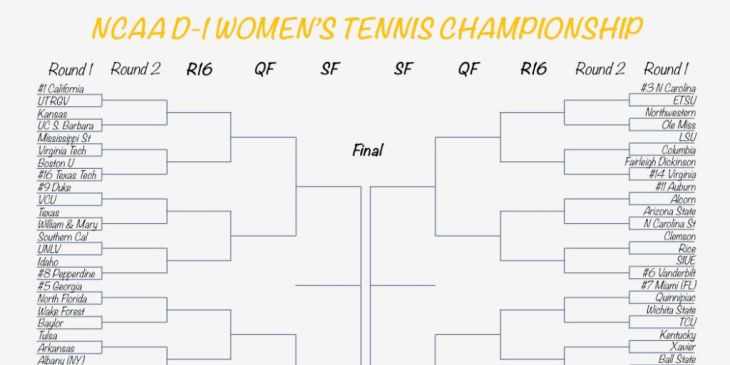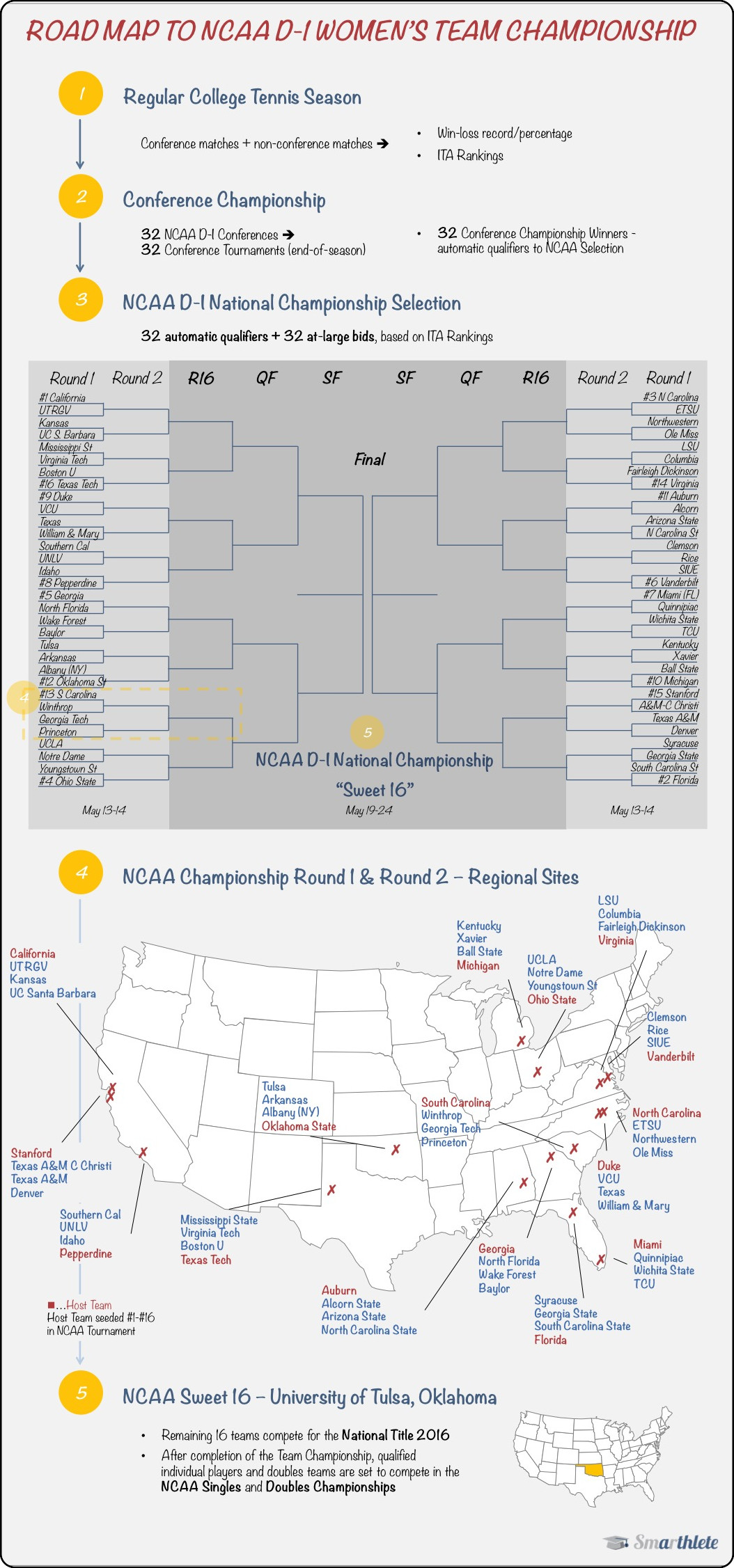Road Map to NCAA D1 Championship in Women's Tennis

If you are an active, maybe even daily, follower of blogs and websites in the world of college tennis, you are probably well-informed and excited about the weeks to come. If you are interested, but haven't yet gotten your head around how this all works - especially with the many different conferences in the NCAA - carry on! This article might be just the right piece of information for you.
Last week we looked at the way men's college tennis determines its national champion in the men's championship. In case you have missed the article and the infographic, find it here. Today it's all about the ladies, who are also about to kick off their final week(s) of college action as we speak. The NCAA Tournament has finally arrived and officially started on Friday, May 13. But trust that all 64 teams have spent quite some time going through their first round opponents' lineups, as well as analyzing the season's results of potential second round opponents, ever since the draw was published last week. Not to forget assigning enough time for on-court preparation to be well-equipped for the doubles and singles decisions.
This week again, we'll go down to a level where we explain what it takes for college tennis teams to qualify for the NCAA Tournament in 5 steps. Without doubt is our goal that by the end of the read, you have gotten so interested in the NCAAs that you are ready to dig right into the analyses, projections, and discussions. We'll offer links to the websites, doing a fantastic job in providing just that.

1. Regular College Tennis Season
The regular season runs from January to the end of April and teams tour the country for dual matches against opponents from their conference as well as programs from other conferences. As the season proceeds, teams collect wins and losses; some against better-ranked programs and others against lower-ranked (or unranked) ones. Whether a program is ranked or not is very important, because wins over ranked programs are of greater value in the ITA's Rankings. In women's NCAA D1 tennis there are a total of 32 conferences - 1 more than on the men's side (America East)! Find a list of them all at the end of this article.*
2. Conference Championships
In 31 out of these 32 conferences a big final showdown is set to happen at the end of the season: a Conference Tournament, which crowns its champion of the year, such as "America East Champion 2016" or "Southwestern Athletic Conference Champion 2016". (Speaking of, Albany (America East) and Alcorn State (SWAC) were this year's Conference Champs.) Depending on the conference, the final tournament may be limited to the top teams of the season. The one league not holding a Conference Championship is the Ivy League, in which the champion is determined through the intra-conference play during the season (2016 League Champion: Princeton).
3. NCAA D1 National Championship Selection
32 conferences equal 32 champions, which receive an automatic bid into the NCAA Selection. With a tournament size of 64, there are additional 32 bids available. This is where the regular college season (see above Step 1) comes into play: The 32 best ranked teams, which have not won the conference title and earned an automatic berth receive an "at-large bid". Due to the varying strength of conferences in general, a lot of the Conference Champions are unranked, which creates the situation that some conferences only send one of their members to the NCAA Championship (Winner of Conference Tournament via automatic bid), whereas others send multiple teams to the Tournament (Winner of Conference Tournament + ranking-based at-large bids). To give you a better idea of how this plays out, here is a comparison:
The Missouri Valley sends 1 representing team (Wichita State University - automatic berth) vs. the Pac 12 with 5 teams (Stanford - automatic berth; California, USC, Arizona State, UCLA - at-large berth)!
The 16 best teams based on the ITA Rankings are seeded and receive the honour of hosting the first two rounds of the NCAA Tournament.
Even the NCAA Selection itself is a huge event for qualified teams! Get a taste of what's going on during these live shows, where the NCAA announces the bracket:
ICYMI: The Cowgirls booked their fifth-straight trip to the NCAA Tournament last night! https://t.co/NO6aYHWIkV
? OSU Women's Tennis (@CowgirlTennis) May 4, 2016
4. NCAA Championships Round 1 & Round 2
The first two rounds are held at campus sites across the country between May 13-15, featuring four teams in a single-elimination format. The hosting teams are obviously in a great position with the support of their home crowd as well as playing conditions their athletes are familiar with. Needless to say that a team like Georgia would certainly feel some additional energy, given its support on the stands:
.@UGAWomensTennis claims the April Attendance Race title on the women's side!
? ITA Tennis (@ITATennis) May 5, 2016
?? Release: https://t.co/XkiUqst1NX pic.twitter.com/3z7TvhJfdg
The winners of the regional tournaments advance to the remainder of the Championship (R16) and have some time to get ready for the big finale a couple days later (May 19-24).
5. NCAA Sweet 16
Following the regional eliminations, the NCAA Tennis Championship (R16, QF, SF, Final) will see the season's strongest teams left in the competition with some obvious contenders for the title, such as this year's dominating team, Florida, having lost just one match in total (vs. 19 wins)! The event, followed by the Singles and Doubles Championships, will be held at the University of Tulsa, Oklahoma.
Tulsa's "Hurricane" themselves qualified by winning their conference title in the American Athletic Conference. They are getting ready to take on Arkansas at Oklahoma State's facilities, facing a potential second round highlight against the squad from Oklahoma State and #12 seed - a possible huge match on the Hurricane's way to represent their school in the Round of 16 some days thereafter:
Make sure to check out these two resources - they will be covering all the live action in the days to come in great detail:
- NCAA Championship Central - Tulsa: Click here
- College Tennis Today - for great matchup projections, analyses, statements, and results by Bobby Knight: Click here
Make sure to check back in some weeks' time for our piece on the Singles/Doubles events, as well as lower college divisions and college tennis impact on the red clay of the French Open! :) Sign up to our blog newsletter to your right or give us a follow on Twitter and Facebook to receive our articles in the Friday Scholarship Guide!
Are you a junior player, considering to become a college tennis player in the near future? Find out what Smarthlete has to offer for you or get started right away by creating a free recruiting profile already today!
*Conferences in women's NCAA D1 tennis:
America East - American Athletic - Atlantic Coast - Atlantic Sun - Atlantic 10 - Big East - Big Sky - Big South - Big Ten - Big 12 - Big West - Colonial - Conference USA - Horizon - Ivy - MAAC - Mid-American - Mid-Eastern - Missouri Valley - Mountain West - Northeast - Ohio Valley - Pacific-12 - Patriot - SEC - Southern - Southland - SWAC - Summit - Sun Belt - West Coast - WAC